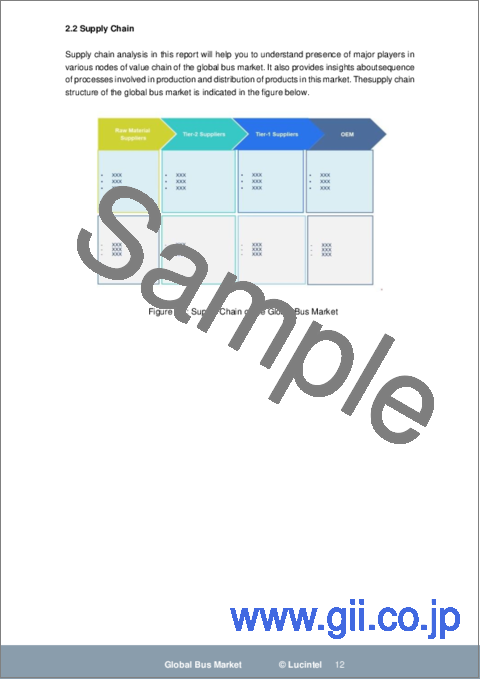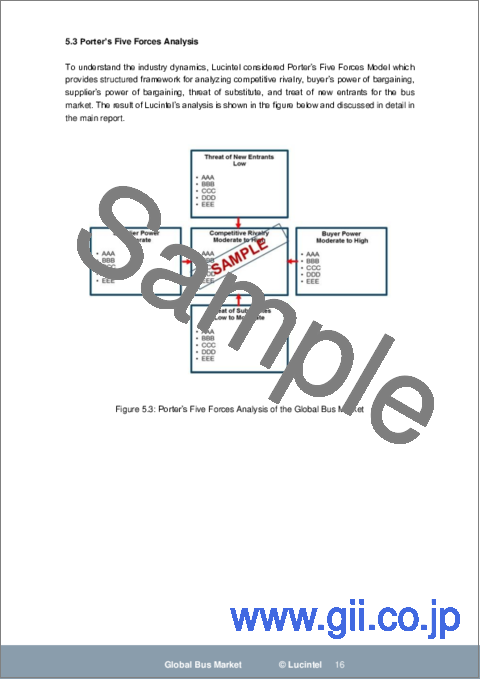|
|
市場調査レポート
商品コード
1418594
バス市場レポート:2030年までの動向、予測、競合分析Bus Market Report: Trends, Forecast and Competitive Analysis to 2030 |
||||||
カスタマイズ可能
適宜更新あり
|
|||||||
| バス市場レポート:2030年までの動向、予測、競合分析 |
|
出版日: 2024年01月29日
発行: Lucintel
ページ情報: 英文 150 - page report
納期: 3営業日
|
- 全表示
- 概要
- 目次
バスの動向と予測
世界のバス市場は、2024年から2030年までのCAGRが5.8%で、2030年までに推定682億米ドルに達すると予想されます。この市場の主要促進要因は、公共輸送における乗客の快適性の重視の高まり、電気自律走行バスの利用可能性の拡大、排出ガスと大気汚染を低減するための環境に優しく持続可能な交通手段への関心の高まりです。世界のバス市場の将来は、交通バス、市外バス・大型バス、スクールバス市場に機会があり、有望視されています。
バス市場洞察
Lucintelは、ディーゼル燃料を動力源とする内燃機関がディーゼルバスの特徴であり、ディーゼルエンジンは信頼性と燃費の良さで定評があるため、バスのような大型車両に適した選択肢であることから、予測期間中もディーゼルが最大セグメントであり続けると予測しています。
アジア太平洋は、人口増加、経済成長、政府の支援政策、効率的な都市交通ソリューションの必要性から、予測期間中に最も高い成長が見込まれています。
よくある質問
Q1.市場規模は?
A1.世界のバス市場は、2030年までに推定682億米ドルに達すると予想されています。
Q2.市場の成長予測は?
A2.世界のバス市場は、2024年から2030年にかけてCAGR 5.8%で成長する見込みです。
Q3.市場の成長に影響を与える主要促進要因は?
A3.この市場の主要促進要因は、公共輸送における乗客の快適性重視の高まり、電動自律走行バスの利用可能性の拡大、排出ガスと大気汚染を低減するための環境に優しく持続可能な交通手段への注目の高まりです。
Q4.市場の主要セグメントは?
A4.世界のバス市場の将来は、交通バス、市外バス・大型バス、スクールバスの各市場における機会が有望です。
Q5.市場の主要企業は?
A5.主要バス会社は以下の通り。
- AB Volvo
- BYD Motors
- Jiangling Motors
- BAIC
- Xiamen King Long Motor
- Shanghai Automotive Industry
- Changan Automobile
Q6.今後、最大となる市場セグメントは?
A6.Lucintelは、ディーゼル燃料を動力源とする内燃機関がディーゼルバスの特徴であり、ディーゼルエンジンはその信頼性と燃費の良さで定評があるため、バスのような大型車には良い選択肢であることから、予測期間中もディーゼルが最大セグメントであり続けると予測しています。
Q7.市場において、今後5年間に最大になると予想される地域は?
A7.アジア太平洋は、人口増加、経済成長、政府の支援政策、効率的な都市交通ソリューションの必要性から、予測期間中最も高い成長が見込まれています。
Q8.レポートのカスタマイズは可能?
A8.はい、Lucintelは追加費用なしで10%のカスタマイズを提供します。
目次
第1章 エグゼクティブサマリー
第2章 世界のバス市場:市場力学
- イントロダクション、背景、分類
- サプライチェーン
- 業界の促進要因と課題
第3章 2018~2030年の市場動向と予測分析
- マクロ経済動向(2018~2023年)と予測(2024~2030年)
- 世界のバス市場の動向(2018~2023年)と予測(2024~2030年)
- タイプ別の世界のバス市場
- シングルデッキ
- ダブルデッキ
- 燃料タイプ別の世界のバス市場
- ディーゼル
- バッテリー電気
- プラグインハイブリッド
- 燃料電池電気
- その他
- 座席数別の世界のバス市場
- 30席以下
- 31~50席
- 50席以上
- 用途別の世界のバス市場
- 交通バス
- 市外バス・大型バス
- スクールバス
- その他
第4章 2018~2030年の地域別の市場動向と予測分析
- 地域別の世界のバス市場
- 北米のバス市場
- 欧州のバス市場
- アジア太平洋のバス市場
- その他地域のバス市場
第5章 競合の分析
- 製品ポートフォリオ分析
- 運用上の統合
- ポーターのファイブフォース分析
第6章 成長機会と戦略分析
- 成長機会分析
- タイプ別の世界のバス市場の成長機会
- 燃料タイプ別の世界のバス市場の成長機会
- 座席数別の世界のバス市場の成長機会
- 用途別の世界のバス市場の成長機会
- 地域別の世界のバス市場の成長機会
- 世界のバス市場の新たな動向
- 戦略的分析
- 新製品の開発
- 世界のバス市場の生産能力の拡大
- 世界のバス市場における合併、買収、合弁事業
- 認証とライセンシング
第7章 有力企業の企業プロファイル
- Ab Volvo
- Byd Motors
- Jiangling Motors
- BAIC
- Xiamen King Long Motor
- Shanghai Automotive Industry
- Changan Automobile
Bus Trends and Forecast
The future of the global bus market looks promising with opportunities in the transit bus, intercity bus/motorcoaches, and school bus markets. The global bus market is expected to reach an estimated $68.2 billion by 2030 with a CAGR of 5.8% from 2024 to 2030. The major drivers for this market are growing emphasis on passenger comfort in public transit, expanding availability of electric autonomous buses, and growing attention on environmentally friendly and sustainable transportation options to lower emissions and air pollution.
A more than 150-page report is developed to help in your business decisions.
Bus by Segment
The study includes a forecast for the global bus by type, fuel type, seating capacity, application, and region.
Bus Market by Type [Shipment Analysis by Value from 2018 to 2030]:
- Single Deck
- Double Deck
Bus Market by Fuel Type [Shipment Analysis by Value from 2018 to 2030]:
- Diesel
- Battery Electric
- Plug-In Hybrid
- Fuel Cell Electric
- Others
Bus Market by Seating Capacity [Shipment Analysis by Value from 2018 to 2030]:
- Up To 30 Seats
- 31 - 50 Seats
- More Than 50 Seats
Bus Market by Application [Shipment Analysis by Value from 2018 to 2030]:
- Transit Bus
- Intercity Bus/Motorcoaches
- School Bus
- Others
Bus Market by Region [Shipment Analysis by Value from 2018 to 2030]:
- North America
- Europe
- Asia Pacific
- The Rest of the World
List of Bus Companies
Companies in the market compete on the basis of product quality offered. Major players in this market focus on expanding their manufacturing facilities, R&D investments, infrastructural development, and leverage integration opportunities across the value chain. With these strategies bus companies cater increasing demand, ensure competitive effectiveness, develop innovative products & technologies, reduce production costs, and expand their customer base. Some of the bus companies profiled in this report include-
- AB Volvo
- BYD Motors
- Jiangling Motors
- BAIC
- Xiamen King Long Motor
- Shanghai Automotive Industry
- Changan Automobile
Bus Market Insights
Lucintel forecasts that diesel will remain the largest segment over the forecast period because the internal combustion engines powered by diesel fuel are a feature of diesel buses, and diesel engines are a good option for larger vehicles like buses owing to their reputation for dependability and fuel economy.
APAC is expected to witness highest growth over the forecast period due to its growing population, economic growth, supportive government policies and the need for efficient urban transport solutions.
Features of the Global Bus Market
Market Size Estimates: Bus market size estimation in terms of value ($B).
Trend and Forecast Analysis: Market trends (2018 to 2023) and forecast (2024 to 2030) by various segments and regions.
Segmentation Analysis: Bus market size by type, fuel type, seating capacity, application, and region in terms of value ($B).
Regional Analysis: Bus market breakdown by North America, Europe, Asia Pacific, and Rest of the World.
Growth Opportunities: Analysis of growth opportunities in different type, fuel type, seating capacity, application, and regions for the bus market.
Strategic Analysis: This includes M&A, new product development, and competitive landscape of the bus market.
Analysis of competitive intensity of the industry based on Porter's Five Forces model.
FAQ
Q1. What is the bus market size?
Answer: The global bus market is expected to reach an estimated $68.2 billion by 2030.
Q2. What is the growth forecast for bus market?
Answer: The global bus market is expected to grow with a CAGR of 5.8% from 2024 to 2030.
Q3. What are the major drivers influencing the growth of the bus market?
Answer: The major drivers for this market are growing emphasis on passenger comfort in public transit, expanding availability of electric autonomous buses, and growing attention on environmentally friendly and sustainable transportation options to lower emissions and air pollution.
Q4. What are the major segments for bus market?
Answer: The future of the global bus market looks promising with opportunities in the transit bus, intercity bus/motorcoaches, and school bus markets.
Q5. Who are the key bus market companies?
Answer: Some of the key bus companies are as follows.
- AB Volvo
- BYD Motors
- Jiangling Motors
- BAIC
- Xiamen King Long Motor
- Shanghai Automotive Industry
- Changan Automobile
Q6. Which bus market segment will be the largest in future?
Answer: Lucintel forecasts that diesel will remain the largest segment over the forecast period because the internal combustion engines powered by diesel fuel are a feature of diesel buses, and diesel engines are a good option for larger vehicles like buses owing to their reputation for dependability and fuel economy.
Q7. In bus market, which region is expected to be the largest in next 5 years?
Answer: APAC is expected to witness highest growth over the forecast period due to its growing population, economic growth, supportive government policies and the need for efficient urban transport solutions.
Q.8 Do we receive customization in this report?
Answer: Yes, Lucintel provides 10% customization without any additional cost.
This report answers following 11 key questions:
- Q.1. What are some of the most promising, high-growth opportunities for the bus market by type (single deck and double deck), fuel type (diesel, battery electric, plug-in hybrid, fuel cell electric, and others), seating capacity (up to 30 seats, 31 - 50 seats, and more than 50 seats), application (transit bus, intercity bus/motorcoaches, school bus, and others), and region (North America, Europe, Asia Pacific, and the Rest of the World)?
- Q.2. Which segments will grow at a faster pace and why?
- Q.3. Which region will grow at a faster pace and why?
- Q.4. What are the key factors affecting market dynamics? What are the key challenges and business risks in this market?
- Q.5. What are the business risks and competitive threats in this market?
- Q.6. What are the emerging trends in this market and the reasons behind them?
- Q.7. What are some of the changing demands of customers in the market?
- Q.8. What are the new developments in the market? Which companies are leading these developments?
- Q.9. Who are the major players in this market? What strategic initiatives are key players pursuing for business growth?
- Q.10. What are some of the competing products in this market and how big of a threat do they pose for loss of market share by material or product substitution?
- Q.11. What M&A activity has occurred in the last 5 years and what has its impact been on the industry?
Table of Contents
1. Executive Summary
2. Global Bus Market : Market Dynamics
- 2.1: Introduction, Background, and Classifications
- 2.2: Supply Chain
- 2.3: Industry Drivers and Challenges
3. Market Trends and Forecast Analysis from 2018 to 2030
- 3.1. Macroeconomic Trends (2018-2023) and Forecast (2024-2030)
- 3.2. Global Bus Market Trends (2018-2023) and Forecast (2024-2030)
- 3.3: Global Bus Market by Type
- 3.3.1: Single Deck
- 3.3.2: Double Deck
- 3.4: Global Bus Market by Fuel Type
- 3.4.1: Diesel
- 3.4.2: Battery Electric
- 3.4.3: Plug-In Hybrid
- 3.4.4: Fuel Cell Electric
- 3.4.5: Others
- 3.5: Global Bus Market by Seating Capacity
- 3.5.1: Up to 30 Seats
- 3.5.2: 31 - 50 Seats
- 3.5.3: More Than 50 Seats
- 3.6: Global Bus Market by Application
- 3.6.1: Transit Bus
- 3.6.2: Intercity Bus/Motorcoaches
- 3.6.3: School Bus
- 3.6.4: Others
4. Market Trends and Forecast Analysis by Region from 2018 to 2030
- 4.1: Global Bus Market by Region
- 4.2: North American Bus Market
- 4.2.2: North American Bus Market by Fuel Type: Diesel, Battery Electric, Plug-In Hybrid, Fuel Cell Electric, and Others
- 4.2.3: North American Bus Market by Seating Capacity: Up to 30 Seats, 31 - 50 Seats, and More Than 50 Seats
- 4.2.4: North American Bus Market by Application: Transit Bus, Intercity Bus/Motorcoaches, School Bus, and Others
- 4.3: European Bus Market
- 4.3.1: European Bus Market by Type: Single Deck and Double Deck
- 4.3.2: European Bus Market by Fuel Type: Diesel, Battery Electric, Plug-In Hybrid, Fuel Cell Electric, and Others
- 4.3.3: European Bus Market by Seating Capacity: Up to 30 Seats, 31 - 50 Seats, and More Than 50 Seats
- 4.3.4: European Bus Market by Application: Transit Bus, Intercity Bus/Motorcoaches, School Bus, and Others
- 4.4: APAC Bus Market
- 4.4.1: APAC Bus Market by Type: Single Deck and Double Deck
- 4.4.2: APAC Bus Market by Fuel Type: Diesel, Battery Electric, Plug-In Hybrid, Fuel Cell Electric, and Others
- 4.4.3: APAC Bus Market by Seating Capacity: Up to 30 Seats, 31 - 50 Seats, and More Than 50 Seats
- 4.4.4: APAC Bus Market by Application: Transit Bus, Intercity Bus/Motorcoaches, School Bus, and Others
- 4.5: ROW Bus Market
- 4.5.1: ROW Bus Market by Type: Single Deck and Double Deck
- 4.5.2: ROW Bus Market by Fuel Type: Diesel, Battery Electric, Plug-In Hybrid, Fuel Cell Electric, and Others
- 4.5.3: ROW Bus Market by Seating Capacity: Up to 30 Seats, 31 - 50 Seats, and More Than 50 Seats
- 4.5.4: ROW Bus Market by Application: Transit Bus, Intercity Bus/Motorcoaches, School Bus, and Others
5. Competitor Analysis
- 5.1: Product Portfolio Analysis
- 5.2: Operational Integration
- 5.3: Porter's Five Forces Analysis
6. Growth Opportunities and Strategic Analysis
- 6.1: Growth Opportunity Analysis
- 6.1.1: Growth Opportunities for the Global Bus Market by Type
- 6.1.2: Growth Opportunities for the Global Bus Market by Fuel Type
- 6.1.3: Growth Opportunities for the Global Bus Market by Seating Capacity
- 6.1.4: Growth Opportunities for the Global Bus Market by Application
- 6.1.5: Growth Opportunities for the Global Bus Market by Region
- 6.2: Emerging Trends in the Global Bus Market
- 6.3: Strategic Analysis
- 6.3.1: New Product Development
- 6.3.2: Capacity Expansion of the Global Bus Market
- 6.3.3: Mergers, Acquisitions, and Joint Ventures in the Global Bus Market
- 6.3.4: Certification and Licensing
7. Company Profiles of Leading Players
- 7.1: Ab Volvo
- 7.2: Byd Motors
- 7.3: Jiangling Motors
- 7.4: BAIC
- 7.5: Xiamen King Long Motor
- 7.6: Shanghai Automotive Industry
- 7.7: Changan Automobile





